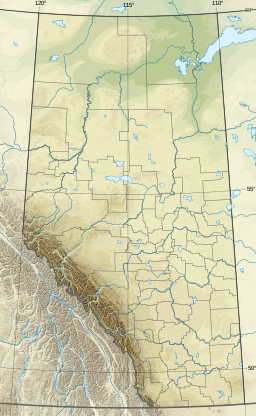| Zama Lake | |
|---|---|
Location of Zama Lake in Alberta | |
| Location | Mackenzie County, Alberta |
| Coordinates | 58°45′N 119°05′W / 58.750°N 119.083°W[1] |
| Primary outflows | Hay River |
| Basin countries | Canada |
| Max. length | 35 km (22 mi) |
| Max. width | 8 km (5.0 mi) |
| Surface area | 55 km2 (21 sq mi) |
| Surface elevation | 320 m (1,050 ft) |
| Settlements | Zama City |
Zama Lake is a large lake in Mackenzie County, in north-western Alberta, Canada.
Major Ernest Wilson Hubbell, Chief Inspector of the Dominion Land Survey,[2] recorded the name "Zammah River" in his field notes as the transliteration of the name of a Slavey Chief (Slavey Indians are now known as the Dene Tha' First Nation). The Geographic Board of Canada recorded the name "Zama River" on 4 July 1922 without explanation for the spelling change. The lake seems to be named in the same fashion and was named on 6 November 1944. The Dene Tha' do not use the name "Zama Lake", but use names in the Slavey language to identify the lake; some use K’ah Woti Túé (“Main Blind Lake” referring to a hunting blind) and others use Tulonh Mieh (“Where the Water Ends”).[3]
The lake is located approximately 25 kilometres (16 mi) northeast of Rainbow Lake and 115 kilometres (71 mi) west northwest of High Level,[3] at the confluence of Zama River and Hay River. The lake covers 55 km2 (21 sq mi) and forms an intricate river, lakes, and wetland system. The Hay-Zama Lakes complex is a Ramsar site for its importance to spring and fall migrating ducks and geese. As many as 250,000 ducks and geese use the lakes during the fall migration.[4]
A small hamlet, Zama City is located approximately 50 kilometres (31 mi) north of the lake[5] and the unincorporated community of Chateh in the Hay Lake 209 Indian reserve of the Dene Tha' First Nation is also located south of the lake.[6]
- ^ "Zama Lake". Geographical Names Data Base. Natural Resources Canada.
- ^ Greene, B.M. (1912). "Hubbell, Major Ernest Wilson". Who's Who and Why. Ottawa: International Press. p. 1213.
- ^ a b Kelland, Ron (21 August 2012). "Zama". RETROactive. Historic Resources Management Branch of Alberta Culture, Multiculturalism, and Status of Women.
- ^ "Hay-Zama Lakes - Ramsar Site". Environment Canada. Retrieved 3 September 2007.
- ^ Zama City.ca
- ^ "First Nation Detail". Crown–Indigenous Relations and Northern Affairs Canada. Government of Canada. 9 April 2019.
